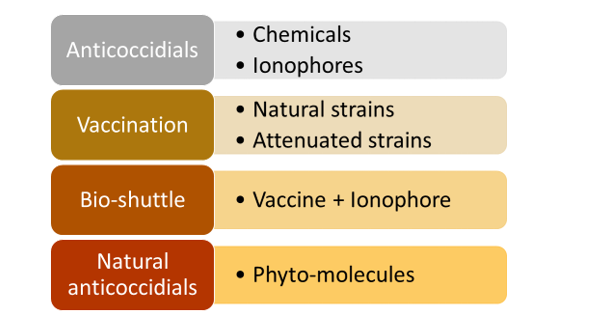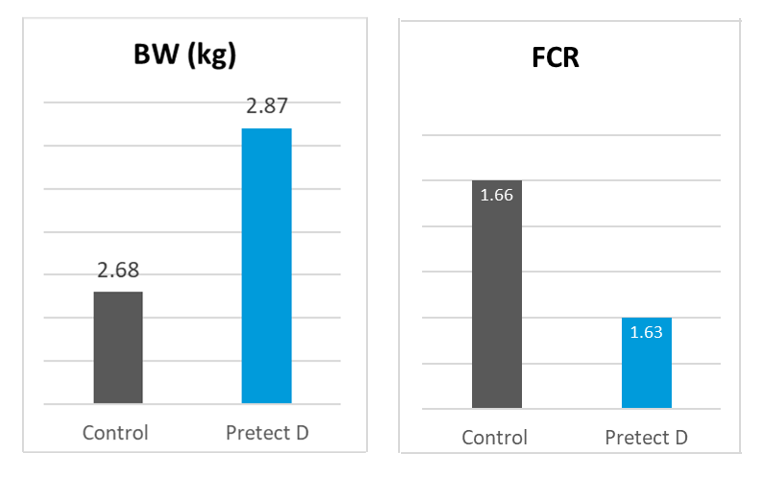



Keep Coccidiosis under control – naturally!
Trials show that Pretect D supports the efficiency of coccidiosis control programsOften you have an extensive coccidiosis control program in place. You don’t observe any clinical signs of Coccidiosis; however, at the end of the cycle, you record significantly lower body weight and a higher FCR. There is a high probability that your animals have subclinical Coccidiosis.
Ways to deal with coccidiosis on the farm
Different tools are widely used to prevent and treat coccidiosis:

Figure 1: Tools to prevent and treat coccidiosis
Traditionally, treatment was heavily dependent on chemicals and ionophores. However, unbridled use of ionophores leads to resistance in Eimeria spp. on the farm, the failure of the control program, and significant performance losses, with high mortality due to coccidiosis. Therefore, the tools mentioned above are inserted in rotation or shuttle programs to minimize the generation of resistances. In a rotation program, the anticoccidial changes from flock to flock. In a shuttle program, the anticoccidial changes within one cycle according to the feed (Chapman, 1997).
However, this strategy is often not 100% effective due to a lack of diversity and overuse of certain tools within programs. The rigorous financial optimization of the program leads to the use of cost-effective but marginally effective solutions. These factors over the period weaken the program, which seems to work well but leads to resistance to anticoccidial drugs and sets up subclinical coccidiosis.
Resistances have been reported in the US (Jeffers, 1974, McDougald, 1981), South America (McDougald, 1987; Kawazoe and Di Fabio, 1994), Europe (Peeters et al., 1994; Bedrník et al., 1989; Stephan et al., 1997), Asia (Lan et al., 2017; Arabkhazaeli et al., 2013), and Africa (Ojimelukwe et al., 2018). Chapman and co-workers (1997) even stated that resistances were documented for all anticoccidial drugs employed at this time, and new products have not been approved for decades.
Resistance and subclinical coccidiosis can be approached naturally
When an anticoccidial has lost its effectiveness due to excessive use, some resistant coccidia survive. They can cause a mild course of the disease, the subclinical coccidiosis, driving costs higher. Reducing the occurrence of resistance and subclinical coccidiosis can significantly decrease the expenses of coccidiosis control programs and, eventually, the cost of production.
Increasing consumer pressure to reduce overall usage of drugs in animal production has driven the innovation efforts toward solutions that can be effectively used within control programs. However, this shift was not easy for the producers. Lack of reliable data, poor understanding of the mode of action, lack of quality optimization, and unsubstantiated claims led to the failure of many earlier-generation natural solutions.
Knowledge, research, and technological developments are now ready to offer solutions that can be an effective part of the coccidia control program and open opportunities to make poultry production even more sustainable by reducing drug dependency.
For centuries, phytomolecules have been used for their medicinal properties and effects on the health and wellbeing of animals and humans. In the case of coccidiosis, tannins and saponins have been proven to support animals in coping with this disease. Tannic acids and tannic acid extracts strengthen the intestinal barrier by reducing oxidative stress and inflammation (Tonda et al., 2018). On the other hand, saponins lessen the shedding of oocysts, improve the lesion score, and, in the case of an acute infection, the occurrence of bloody diarrhea (Youssef et al., 2021).
These natural substances can be integrated into shuttle or rotation programs to reduce the use of anticoccidials and, therefore, minimize resistance development.
Pretect D: Coccidiosis programs can be strengthened naturally!
In an EU field trial conducted with more than 200 000 birds, Pretect D (a natural phytogenic-based product designed to increase the efficacy of coccidiosis control) was used in the shuttle program together with ionophores. The trial provided excellent results on zootechnical performance (figures 2-5).


Figures 2-5: Zootechnical performance of broilers with Pretect D included in the shuttle program
Trials show that Pretect D supports the efficiency of coccidiosis control programs by impairing the Eimeria development cycle, when used in combination with vaccines, ionophores, and chemicals as part of the shuttle or rotation program:
- Protecting the epithelium from inflammatory and oxidative damage
- Promoting the restoration of the mucosal barrier function
Table 1 exemplifies a way of adapting natural solution (Pretect D) to actual coccidiosis control programs.

Table 1: Example of including Pretect D into coccidiosis control programs
Natural solutions suit both farmers and consumers
With phytomolecules partly replacing anticoccidials in rotation or shuttle programs, the use of anticoccidials in poultry production can be decreased. On the one hand, this answers consumers’ demand; on the other hand, it leads to a reduction of resistances in the long run. The returning effectiveness of the anticoccidials can reduce subclinical coccidiosis, leading to a higher profit for the farmers.
*References available on request









